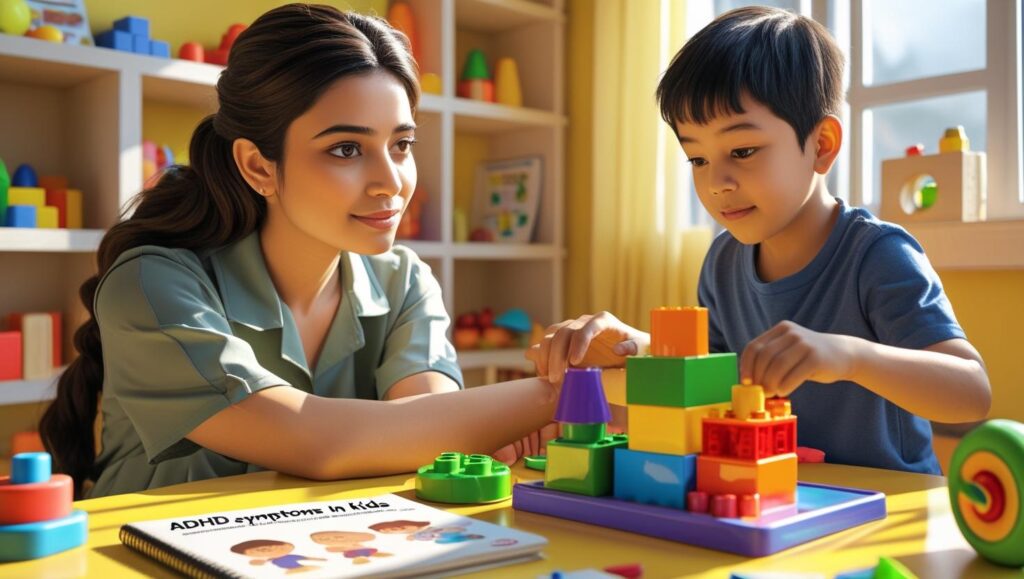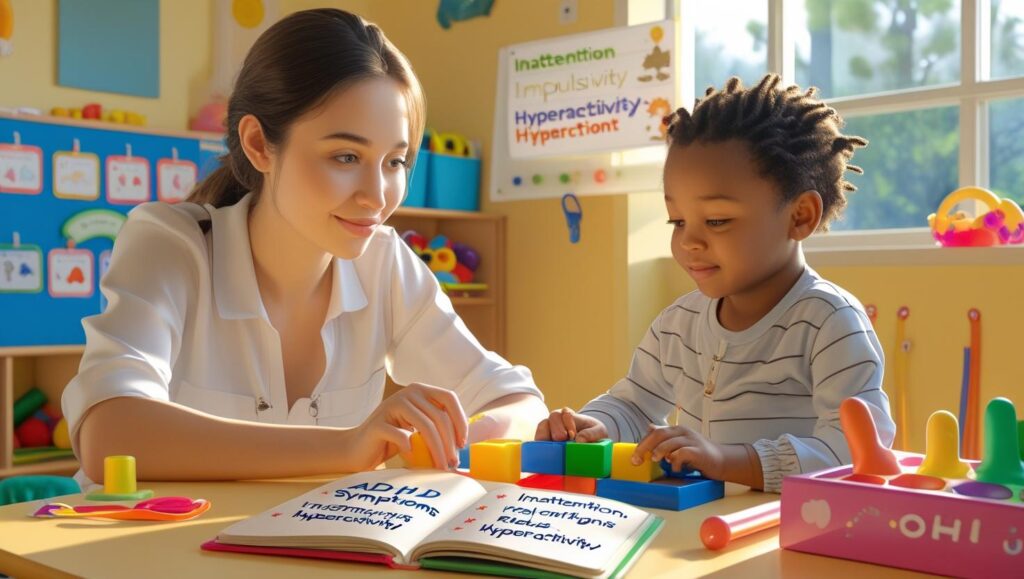Attention-Deficit/Hyperactivity Disorder (ADHD) is a common neurodevelopmental disorder that affects millions of children worldwide. It is characterized by persistent patterns of inattention, hyperactivity, and impulsivity that interfere with daily functioning and development. Recognizing the symptoms early can lead to better management and support for affected children.
In this blog post, we will explore the key symptoms of ADHD in children, how they manifest in different settings, and when parents should seek professional help.

Understanding ADHD in Children
ADHD is typically diagnosed in childhood, often between the ages of 6 and 12, though symptoms may appear as early as preschool. The disorder is divided into three primary subtypes:
- Predominantly Inattentive Presentation– Difficulty focusing, following instructions, and staying organized.
- Predominantly Hyperactive-Impulsive Presentation– Excessive fidgeting, talking, and impulsive actions.
- Combined Presentation– A mix of inattentive and hyperactive-impulsive symptoms.
Each child with ADHD may display symptoms differently, making it essential to observe behavior across various environments (home, school, and social settings).
Common Symptoms of ADHD in Children
1. Inattention Symptoms
Children with inattentive ADHD often struggle with focus, organization, and task completion. Key signs include:
- Difficulty sustaining attention– Easily distracted, especially during tasks that require prolonged mental effort (e.g., homework or reading).
- Frequent careless mistakes– Rushing through schoolwork or chores without paying attention to details.
- Trouble following instructions– Struggling to complete multi-step tasks or frequently forgetting directions.
- Avoiding tasks requiring focus– Reluctance to engage in activities that demand sustained mental effort.
- Forgetfulness– Frequently losing items like school supplies, toys, or homework.
- Daydreaming– Appearing “zoned out” or disengaged during conversations or lessons.
These symptoms can lead to academic struggles, as children may miss important details in assignments or fail to complete tasks on time.
2. Hyperactivity Symptoms
Hyperactivity in ADHD is often more noticeable, especially in younger children. Common signs include:
- Excessive fidgeting– Constantly tapping hands or feet, squirming in seats, or playing with objects.
- Difficulty staying seated– Getting up frequently in class or during meals when expected to remain seated.
- Running or climbing inappropriately– Acting overly energetic in situations where it’s not suitable (e.g., climbing furniture at home).
- Excessive talking– Talking nonstop, interrupting others, or blurting out answers before questions are finished.
- Always “on the go”– Appearing restless, as if driven by a motor.
Hyperactive behaviors tend to decrease with age, but teens and adults with ADHD may still experience inner restlessness.
3. Impulsivity Symptoms

Impulsivity can lead to social and behavioral challenges. Signs include:
- Interrupting conversations– Difficulty waiting their turn in discussions or games.
- Acting without thinking– Making hasty decisions, such as running into the street without looking.
- Difficulty waiting– Struggling with patience in lines or turn-taking activities.
- Emotional outbursts– Reacting strongly to minor frustrations or having trouble regulating emotions.
Impulsive behaviors can sometimes be mistaken for defiance or poor discipline, but they stem from neurological differences in self-regulation.
How ADHD Symptoms Vary by Age
ADHD symptoms evolve as children grow:
Preschoolers (Ages 3-5)
- Extreme restlessness
- Frequent tantrums
- Difficulty playing quietly
- Running or climbing excessively
Elementary School Children (Ages 6-12)
- Academic struggles due to inattention
- Social challenges (interrupting peers, difficulty following game rules)
- Forgetfulness with homework or chores
- Fidgeting during class
Teenagers (Ages 13-18)
- Poor time management
- Risky behaviors (speeding, impulsive decisions)
- Difficulty organizing schoolwork
- Emotional dysregulation (mood swings)
While hyperactivity may lessen with age, inattention and impulsivity often persist into adulthood.

ADHD in Boys vs. Girls
Research shows that ADHD symptoms can present differently based on gender:
- Boysare more likely to exhibit hyperactive and impulsive behaviors, leading to earlier diagnosis.
- Girlsoften display inattentive symptoms (daydreaming, forgetfulness), which may be overlooked as shyness or anxiety.
Because girls with ADHD are less disruptive, they are frequently underdiagnosed, leading to academic and emotional challenges later in life.
When to Seek Professional Help
Not every energetic or distracted child has ADHD. However, if symptoms:
- Persist for6 months or longer
- Occur inmultiple settings(home, school, extracurriculars)
- Interfere with academic performance or social relationships
…then a professional evaluation is recommended. Diagnosis involves:
- Parent and teacher questionnaires
- Behavioral assessments
- Medical exams to rule out other conditions (e.g., hearing problems, sleep disorders)
Conclusion
Recognizing ADHD symptoms in children is crucial for early intervention and support. While all kids can be forgetful or energetic at times, persistent patterns of inattention, hyperactivity, or impulsivity may indicate ADHD. If you suspect your child has ADHD, consult a pediatrician or mental health professional for an accurate assessment.
With the right strategies—such as behavioral therapy, classroom accommodations, and, in some cases, medication—children with ADHD can thrive academically, socially, and emotionally.
Would you like additional resources on managing ADHD in children? Let us know in the comments!
![]()






